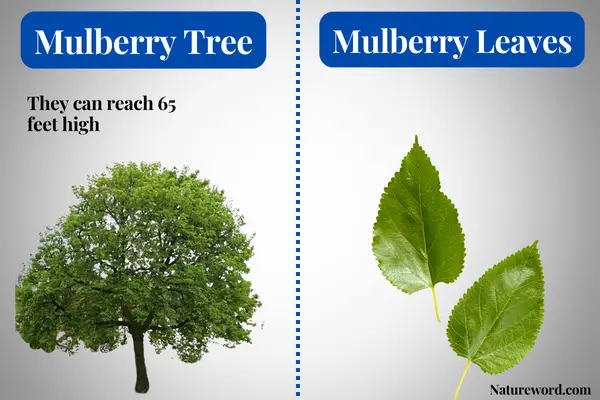When it comes to eating berries, mulberries are one of the finest choices to munch on. These little, juicy, colorful berries are not only a treat to your taste buds but are packed with a variety of nutrients. You won’t believe but nature has sent these tiny packages fully packed with nutrients like iron, vitamin C, minerals, and various important plant components that can benefit your health in a variety of ways.
However, to reap maximum benefits, you must acquire the right fruit and the right species. To help you with identifying mulberries, we’ve curated this article with all the essential information for easy recognition. So, let’s begin.
How do I identify a mulberry?
Mulberries are fruits of the mulberry tree. It is a plant with the genus Morus and different species like alba, nigra, rubra, etc. This genus usually includes a wide collection of trees and shrubs cultivated all across Asia, Africa, America, Europe, etc. So, before we began with the characteristics of the fruit, let’s find out how to identify the mulberry tree.
Although many different species of mulberry can be found, three primary cultivars are planted all over the world. Red mulberry trees yield red berries, white bears white fruit, and black mulberry trees produce berries that are dark purple to black in hue. The fruit is always extremely bitter before it is fully mature.
How to identify the mulberry tree

Mulberry trees are mostly identified by their leaves which are alternately arranged on the stem branches. The leaves mostly have saw-like edges and are often lobed. The mulberry tree is deciduous. It sheds its leaves in autumn and has the new ones growing in spring. You could easily see silk worms feasting on these leaves when they are fully grown.
As mentioned above, depending on the species of the fruit, mulberry trees also come in different types. However, the structure of the leaves is mostly the same. But the leaves of the red mulberry tree are naturally textured and feel more like sandpaper on the lower side. However, the white and black mulberry leaves are mostly smooth on both sides.
Besides the leaves, mulberry trees have some other distinguishing features. For instance, the red mulberry trees can grow up to 65 feet high while the white mulberry grows 40 feet tall, and finally, the black mulberry tree is a medium-sized tree and can grow up to 12 meters.
Furthermore, the bark of the tree also differs in the three species. The red mulberry tree has distinctive red-to-brown bark, the white one has ochre-gray colored bark while the black mulberry tree has dull-grey to brown bark.
In the mid of the spring season, these trees are loaded with clusters of flowers on their branches. It is from these flower clusters that the mulberry fruit develops and is called a multiple. Initially, they look like blackberries but turn to different colors when ripen.
Characteristic features of Mulberries
Mulberries come in a wide variety, making it challenging to give a basic description, but generally speaking, they grow quite swiftly as young plants before slowing down as the trees get older.
Just like the trees, the fruit also comes in three obvious varieties as explained below;

Similarly, the white berries are also drupes and are made up of a group of little fruits, each containing a seed. They begin green, change to white, pink, and, in certain types, dark crimson before returning to green. Although some types taste like black mulberries, white berries are only a little sweet.
In the same manner, red mulberries are cluster fruits usually dark orange to red. They usually taste sweet and each fruit has a seed in it. So, the major difference between the fruits will be their color and some amount of nutrients.
Also, depending on the kind, mulberries can be either hardy or tender. Others would rather avoid being exposed to temperatures below freezing, while some can withstand extremely cold conditions and difficult winters.
What do you use mulberries for?
Mulberries are an excellent dose of nutrients like iron, vitamin C, and several plant components. Thus, they have been related to reduced risk of cancer, high blood pressure, and cholesterol. Although there is scant evidence to support their efficacy, these fruits have also been utilized for thousands of years in Chinese herbal medicine to cure a variety of ailments.
Industrially, the mulberry is particularly valuable as a food supply for the silkworm, an animal known for producing incredibly strong protein strands that may be utilized to create fabrics. Mulberry trees can also be very helpful in the creation of paper, particularly in Asia. Commercial applications for mulberry fruit include fruit wines, jams, and preservatives.
Additionally, mulberry trees may be quite beautiful when used as ornaments. The species that rarely grow to a height of 40 feet, can be pruned and shaped to a particular shape. Mulberries are popular for growing since they may be used as food and the greenery can be quite lovely. The fruit of ornamental mulberries can get untidy if it is not used, which is the only downside.
Knowing all the amazing benefits and uses, are you thinking of having these lovelies in your garden? Well, if you want to grow mulberries, talk to the professionals at a nearby plant nursery about the types that will thrive there so you may get a sturdy, robust tree.
